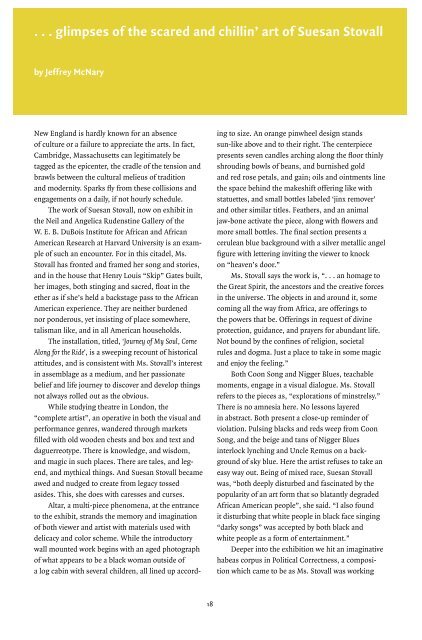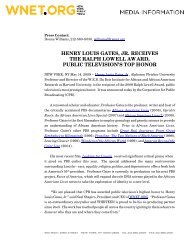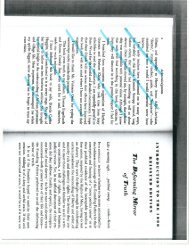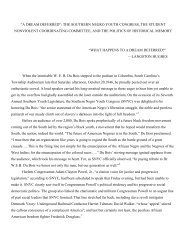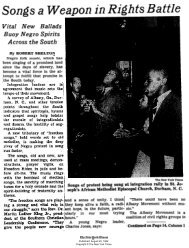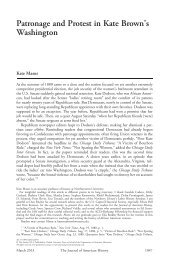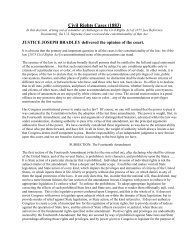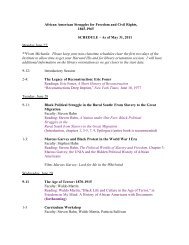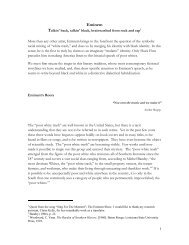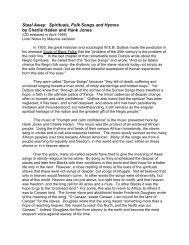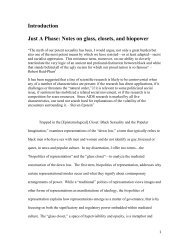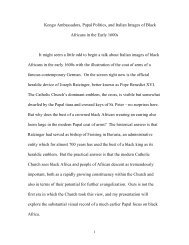AR-v.5 (1-27):Layout 1 - Hutchins Center - Harvard University
AR-v.5 (1-27):Layout 1 - Hutchins Center - Harvard University
AR-v.5 (1-27):Layout 1 - Hutchins Center - Harvard University
You also want an ePaper? Increase the reach of your titles
YUMPU automatically turns print PDFs into web optimized ePapers that Google loves.
. . . glimpses of the scared and chillin’ art of Suesan Stovallby Jeffrey McNaryNew England is hardly known for an absenceof culture or a failure to appreciate the arts. In fact,Cambridge, Massachusetts can legitimately betagged as the epicenter, the cradle of the tension andbrawls between the cultural melieus of traditionand modernity. Sparks fly from these collisions andengagements on a daily, if not hourly schedule.The work of Suesan Stovall, now on exhibit inthe Neil and Angelica Rudenstine Gallery of theW. E. B. DuBois Institute for African and AfricanAmerican Research at <strong>Harvard</strong> <strong>University</strong> is an exampleof such an encounter. For in this citadel, Ms.Stovall has fronted and framed her song and stories,and in the house that Henry Louis “Skip” Gates built,her images, both stinging and sacred, float in theether as if she’s held a backstage pass to the AfricanAmerican experience. They are neither burdenednor ponderous, yet insisting of place somewhere,talisman like, and in all American households.The installation, titled, ‘Journey of My Soul, ComeAlong for the Ride’, is a sweeping recount of historicalattitudes, and is consistent with Ms. Stovall’s interestin assemblage as a medium, and her passionatebelief and life journey to discover and develop thingsnot always rolled out as the obvious.While studying theatre in London, the“complete artist”, an operative in both the visual andperformance genres, wandered through marketsfilled with old wooden chests and box and text anddaguerreotype. There is knowledge, and wisdom,and magic in such places. There are tales, and legend,and mythical things. And Suesan Stovall becameawed and nudged to create from legacy tossedasides. This, she does with caresses and curses.Altar, a multi-piece phenomena, at the entranceto the exhibit, strands the memory and imaginationof both viewer and artist with materials used withdelicacy and color scheme. While the introductorywall mounted work begins with an aged photographof what appears to be a black woman outside ofa log cabin with several children, all lined up accordingto size. An orange pinwheel design standssun-like above and to their right. The centerpiecepresents seven candles arching along the floor thinlyshrouding bowls of beans, and burnished goldand red rose petals, and gain; oils and ointments linethe space behind the makeshift offering like withstatuettes, and small bottles labeled ‘jinx remover’and other similar titles. Feathers, and an animaljaw-bone activate the piece, along with flowers andmore small bottles. The final section presents acerulean blue background with a silver metallic angelfigure with lettering inviting the viewer to knockon “heaven’s door.”Ms. Stovall says the work is, “. . . an homage tothe Great Spirit, the ancestors and the creative forcesin the universe. The objects in and around it, somecoming all the way from Africa, are offerings tothe powers that be. Offerings in request of divineprotection, guidance, and prayers for abundant life.Not bound by the confines of religion, societalrules and dogma. Just a place to take in some magicand enjoy the feeling.”Both Coon Song and Nigger Blues, teachablemoments, engage in a visual dialogue. Ms. Stovallrefers to the pieces as, “explorations of minstrelsy.”There is no amnesia here. No lessons layeredin abstract. Both present a close-up reminder ofviolation. Pulsing blacks and reds weep from CoonSong, and the beige and tans of Nigger Bluesinterlock lynching and Uncle Remus on a backgroundof sky blue. Here the artist refuses to take aneasy way out. Being of mixed race, Suesan Stovallwas, “both deeply disturbed and fascinated by thepopularity of an art form that so blatantly degradedAfrican American people”, she said. “I also foundit disturbing that white people in black face singing“darky songs” was accepted by both black andwhite people as a form of entertainment.”Deeper into the exhibition we hit an imaginativehabeas corpus in Political Correctness, a compositionwhich came to be as Ms. Stovall was working18


